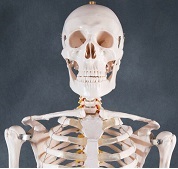|
Anyone make jewelry? I dated a girl briefly that made jewelry professionally, but I've never done it myself. I do, however, do a lot of hot work with copper alloys and some larger metalworking/fabrication, so I have some foundation for how the metal behaves and the general gist of how to machine, solder, braze, cut, form, and fit metal. I want to make a late bday gift for a friend, some kind of brass charm/necklace with one of her emblems. Construction I had in mind is either a solid machined brass pendant with a stainless inlay, or a necklace charm made of brass rod/wire in a ring. I went out today, got some 1 ft lengths of brass rod and spent the afternoon working out how to anneal, form, and solder this grade of brass (260, which I've never worked with).  The only tools I have that are on this scale are a set of needle files and a small (but not quite small enough) anvil. I managed to improvise using a plumbing torch and 1/8" lead-free to solder 3/64" brass rod by using a nub of 1/8" brass rod as basically a soldering iron. Can anyone recommend cheap essential tools? I don't have much in the way of jewelry-specific tools. I have tools for plumbing, electronics soldering, woodworking, and a decent spread of basics, but trying to work on jewelry with tools this size is like trying to tie my shoes with boxing gloves on. Specifically I need: - A way to position assemblies while I solder them - Soldering torch, solder, flux that works well for thin brass wire (say 1/32" to 1/8") - A good way to clean scale off of small workpieces after soldering or annealing - Tools for cutting, shaping, and polishing small workpieces
|
|
|
|

|
| # ? May 9, 2024 19:28 |
|
1 a third hand is great for light soldering of jump rings and wire assemblies like that one, lets you get all around the work; for flattish stuff where you can lay your stuff out and torch it from the top a magnesia block or refractory brick also works well. 2. An air-acetylene or oxypropane torch will be in the right temperature range for like 99% of jewelry soldering, they're commonly available used. Oxy is a more expensive initial setup (twice as many tanks, twice as much hose, and it has to be the nice poo poo propane won't eat) but has some added flexibility for heat control and is great if you also do any welding. handy flux is fine for everything. It's harder to get a reasonably good color-match soldering brass but you can get yellow solders from rio grande that'll be passable until the piece starts to oxidize, or just use silver solder and accept that it'll be a little bit visible unless you're extremely good at making tight joints 3. Get some kind of pot with a lined interior (ceramic or teflon in good condition, no metal exposed) and pickle your stuff in sparex to strip off most of the scale and crud. Do not use that pot for food. If you gently caress up and contaminate your pickle with anything ferrous you can expect your stuff to come out with a pink layer of copper plating, that solution will have to be thrown out but otherwise a 2lb bag lasts most of forever. 4. You got needle files already, and they're your best friend. A little jeweler's saw and a wooden block to brace your work against while you file/saw will come in very handy. jeweler's rouge and buffing wheels for polishing your work to a high sheen, a burnishing iron (just a smooth steel rod you rub the piece with until your fingers fall off to harden it) or if you're fancy a tumbler and steel shot, round nose and parallel-jaw pliers for forming, a ring mandrel for making and sizing rings. a dremel or flex shaft will significantly speed up a lot of grinding/polishing operations. A Wizard of Goatse fucked around with this message at 06:40 on Sep 18, 2023 |
|
|
|
A Wizard of Goatse posted:1 a third hand is great for light soldering of jump rings and wire assemblies like that one, lets you get all around the work; for flattish stuff where you can lay your stuff out and torch it from the top a magnesia block or refractory brick also works well. Awesome, thanks for the info. I'll look up rio grande for yellow solders. I'm pretty good at making tight-fitting joints for macro-scale brazing, and I managed some decent mitered joints for the rings I was practicing with, though the amount of solder was hard to control. With some judicious filing, I think I can make good-looking joints. Does the magnesia block have issues with contaminating molten flux? I'll see how much I can do with a plumber's torch and a can of mapp-pro. The flame temperature is whatever but I'm hoping I can get away with it since these are really small workpieces. I managed to join brass to brass with lead-free plumbing solder no sweat, and next up, I'm gonna try joining small sheets of brass to 430 stainless with high-silver brazing wire and white brazing flux. I'll check out that sparex stuff as well, hopefully it'll do the job for everything non-ferrous. If I hammer my workpiece against a cast iron anvil or brush/file/cut it with steel tools, would this be a contamination risk? For workholding, I've got a bench vise with diamond-cut steel jaws and a panavise. what else should I think about?
|
|
|
|
Contamination from the block shouldn't be a problem, i usually use refractory brick because I've got a crate of em, sometimes if I use too much a bit of un-evaporated flux will glue to the brick and snap a bit off when I remove the piece, if I don't file it off it just falls off in the pickle . The main issue is contamination from using steel pots, touching stuff in the pickle with steel tweezers/wire, leaving bits of steel wool on the piece or, yeah, having some steel in your assembly. The copper plate it'll do is thin, you should be able to polish it off, on brass it's just a hassle but it's a bigger deal if you're working with gold or some poo poo where every file stroke is removing like $50 of material Heat control is a big issue with jewelry soldering, plumbing torches splash it everywhere but if you want to do anything much more sophisticated than a jump ring a torch that does a tighter flame that affects a smaller area at a time will make your life enormously easier. You can get some of the way there, kinda, soaking up excess heat by immersing parts you aren't working on in water or protecting them with a big metalworking vise or the like. complex assemblies with stonesetting or the like also often use 'soft' and 'hard' solders that have different melt points, so you can solder a joint and then work right next to it without remelting it. iirc for example this one used two grades of solder, one for the front bezel and one for the back loops   I tend to use a lot of my welding equipment so I'll put stuff together with a big bench vise or just hold it with needlenose pliers while I torch it, whatever holds it steady enough for you is fine and paste flux does a passable job gluing solder flakes to the workpiece, you don't have to be physically securing absolutely everything. Don't worry too much about being delicate or having a spotless finish right out of the brazing stage, especially with brass you can expect to make a real mess and clean it up with files later. A Wizard of Goatse fucked around with this message at 05:15 on Sep 19, 2023 |
|
|
|
After a different thing eating up my night every night this week, I finally managed to get a little shop time. I'm going to be on a work trip for the next 2 weeks, so I'm trying to get together a kit I can take with me and work on stuff in my hotel room so I don't go insane. First project is a necklace for a friend. I rough-modeled it in solidworks, marked off the major boundaries, and I'm going to file the profile to shape. I'll probably drill/engrave finer surface features as well.  K&S metals sells small sheets, rods & tubes of brass, stainless, and aluminum in all of the small hardware stores near me. On their website, they sell random variety packs of cutoffs, so I bought 2 lb of what they sweep off their shop floor. Most of it is short tubes in brass and aluminum, with a few sheets and rods mixed in. I figure this will last me basically forever. A Wizard of Goatse posted:Contamination from the block shouldn't be a problem, i usually use refractory brick because I've got a crate of em, sometimes if I use too much a bit of un-evaporated flux will glue to the brick and snap a bit off when I remove the piece, if I don't file it off it just falls off in the pickle . The main issue is contamination from using steel pots, touching stuff in the pickle with steel tweezers/wire, leaving bits of steel wool on the piece or, yeah, having some steel in your assembly. The copper plate it'll do is thin, you should be able to polish it off, on brass it's just a hassle but it's a bigger deal if you're working with gold or some poo poo where every file stroke is removing like $50 of material I think I'm going to try a cheap butane torch to get some control over heating. I grabbed some consumables from work (phos-copper brazing rod, high-silver brazing wire, white flux, kaowool blanket), gonna see how those treat me. I'll see how much control I can get over melting adjacent joints as well. I do a lot of irritating brazing at work where the joint is on a copper run that's like 1" long and connected to a heat-sensitive component, so I know how to keep heat where I want it. If that fails, I guess I can try a solder chip variety pack. Most of what I'm trying to figure out is how to keep from laying down giant blobs of solder. Might start with a graphite pencil to keep flow away. And there's always the perpetual question of "How do I hold onto this part" when I'm doing something that applies force or heat to it. Also, nice work 
|
|
|
|
I haven't done any silver work for years but I can still recall a couple of things. I used to mainly use pick soldering to assemble things, if you don't already know what that is it's where you use a sharp tungsten rod to pick up little tiny bits of molten solder that you then place on your joint, works pretty well if you can get the hang of it. Oh yeah get a bunch of small wooden sticks of various profiles you can tape sandpaper around, change the paper out more often than you think you need to. Sealing wax specifically the modern stuff that is hard and mostly made of shellac is great for holding things while doing cold work like filing, glue your work down to a plate/bit of wood ect and when you are done you can melt most of it off with heat and dissolve the rest with denatured alcohol Marking fluid or dychem is great stuff I totally recommend you get some, a small bottle should last you a lifetime. Cheap pliers you don't care about, If you have access to a grinder and a dremel you can reshape the jaws in many useful ways.
|
|
|
|

|
| # ? May 9, 2024 19:28 |
|
The way I was taught to do it was to cut tiny chips of solder and lay them on the piece, so you can precisely control the amount. Paste flux will hold them in place until it liquefies and if you're doing it right there's only a fraction of a second between that and the solder itself melting and flowing into the joint.
|
|
|






